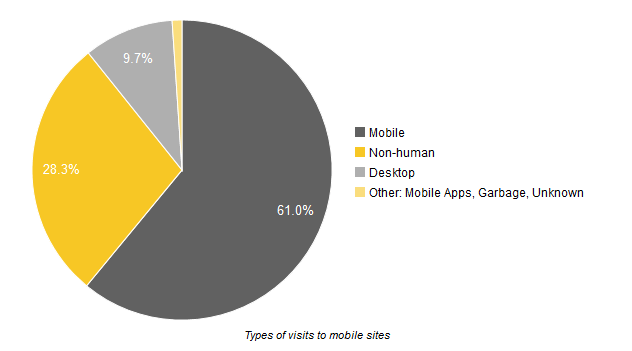As the proportion of traffic from mobile devices continues to ramp, savvy marketers and web strategists are taking the time to understand exactly what the nature of that traffic is.
- With visits coming from a range of devices, both human and machine driven, just how do you make sense of the range mobile traffic you are getting?
- As new devices emerge on an almost daily basis, just how quickly does the profile of mobile traffic change?
- What are the characteristics of the devices that are visiting the site, and how does that translate to conversion rates?
To answer this, we looked at traffic coming from thousands of mobile websites across the world built on the goMobi (now discontinued) platform. This data gives a unique insight into the nature of a broad swath of device traffic using User Agent string analysis performed by the DeviceAtlas API.

Image: jermeny Keith
We looked at 2 months worth of traffic from thousands of goMobi sites. Here's the breakdown:
61% Traffic that came from mobile devices (smartphones, feature phones, tablets, games consoles, eReaders or media players)
28% Traffic that came from non human sources
10% Traffic that came from desktop browsers

Mobile device traffic
- Almost all (97%) of the traffic from mobile devices were from mobile phones and tablets. The remaining 3% was made up by games consoles, eReaders, media players and a small amount of generic UA's plus some random junk.
- Feature phones and low-end smartphones (e.g. Nokia Asha series, older Blackberry phones, etc.) represented about 6% of all mobile traffic.
- Mobile phones generated four times more visits than tablets, but this picture continues to shift in favor of tablets over time.
Non-Human Traffic
Mobile devices are not the only "visitors" we tracked. Some 28% of visits were from non-human sources. Robots, crawlers, checkers, feed fetchers, spam and so on. A large part of robot traffic is made up of Google crawlers. Their presence in logs massively changes the overall picture of site visitors.
An interesting aside here: by looking at traffic in terms of the percentage of unique User-Agents to percentage of unique visits shows just how much traffic the Googlebot and other search engines generate. A very small number of UAs drive that 28% of non human traffic. While a very diverse set of UA's account for the traffic from mobile devices. This UA diversity underlines the sheer variety of mobile devices and browsers combinations that are active on the real web.
| User-Agent Type | Visits (%) | Unique UAs (%) |
|---|---|---|
| Mobile device | 60.97 | 91.67 |
| Desktop | 9.68 | 6.46 |
| Non-human | 28.29 | 0.88 |
The most active robot UAs are Googlebots and other indexing agents:
Mozilla/5.0 (compatible; Googlebot/2.1; +http://www.google.com/bot.html)
Mozilla/5.0 (iPhone; CPU iPhone OS 6_0 like Mac OS X) AppleWebKit/536.26 (KHTML, like Gecko) Version/6.0 Mobile/10A5376e Safari/8536.25 (compatible; Googlebot/2.1; +http://www.google.com/bot.html)
SAMSUNG-SGH-E250/1.0 Profile/MIDP-2.0 Configuration/CLDC-1.1 UP.Browser/6.2.3.3.c.1.101 (GUI) MMP/2.0 (compatible; Googlebot-Mobile/2.1; +http://www.google.com/bot.html)
DoCoMo/2.0 N905i(c100;TB;W24H16) (compatible; Googlebot-Mobile/2.1; +http://www.google.com/bot.html)
Mozilla/5.0 (compatible; bingbot/2.0; +http://www.bing.com/bingbot.htm)
Key Takeaways
- Mobile traffic is not uniform. Device diversity guarantees that your mobile traffic will be coming from a set of devices ranging from tablets, to high-end smartphones with modern browsers to low-end feature phones with variable support for features in a range of older default browsers.
- You have to cater to a range of physically different devices with a wide range of differing screen sizes.
- ll the factors above can't be overestimated when we talk about user-focused web design or user experience.
Notes
- You can go analyse your traffic as deeply as you like, if you understand it at device level. Device identification is only the tip of the iceberg, and you may want to look to at other factors such as OS, specific device capabilities for example presence of camera, GPS and so on.
- The data is based on visits rather than hits to avoid skewing the results by heavy-browsing devices. that are more A visit is defined as a unique combination of IP address, User-Agent, date, and visited host.
For the original version of this article, head over to our mobiForge resource site for all things mobile and web related.
Improve UX with deep insight on what devices are accessing your web site and apps
Looking for the best method to get a detailed view of all device traffic to your website or app? Use DeviceAtlas device detection solution and start your trial at no cost.




